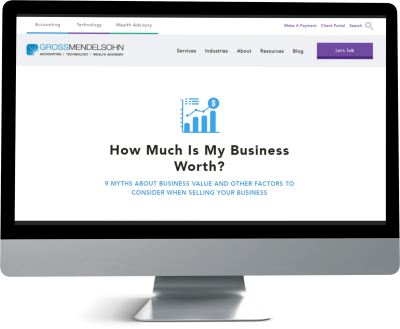Motivational speaker Zig Ziglar once said “how you see your future is much more important than what happened in the past.” The same holds true for business owners and how they view their businesses.
Concentrating on where the company is going is more important than dwelling on where it has been in the past. However, there is tremendous value in your company’s historical financial statements. They can tell you a lot about your company’s past performance, which in turn, can be used to help chart the course of your business for the future.
There are a number of ways to evaluate past performance using various types of financial ratios. The main types are leverage, profitability and liquidity ratios. All of the ratios in these categories are important but there are four financial ratios in particular that help answer the question, “Where’s the cash?!”
As CPAs, we run into many situations where the income statement shows that a business is profitable and making money, but cash flow always seems to be an issue. The business owner inevitably asks, “if my company is doing so well, why is cash always so tight?”
Ratio #1: Days Sales In Accounts Receivable
The first ratio to investigate is days sales in accounts receivable, which you can figure out with a simple calculation. Start with your accounts receivable and divide it by annual sales (actual or projected), then divide that by 365. This tells you how many days of sales have not been collected.
Some people get concerned because pure dollars of accounts receivable increase but that’s okay as long as sales are increasing at an even faster rate. If you find your days sales in accounts receivable increasing significantly, then you should implement special efforts to increase the rate of collections.
Ratio #2: Inventory Turnover
The second ratio is the inventory turnover ratio. This is your cost of sales divided by your inventory. All financial accounting classes teach that inventory is an asset, but from a management accounting standpoint, too much inventory is a liability.
Yes, you need to have enough inventory to fulfill sales orders and we all know that managing to have just the right amount of inventory is difficult.
When interest rates are very low as they have been in recent years, carrying excess inventory doesn’t hurt the bottom line as much as it does in periods of rising or high interest rates. It does, however, greatly impact your cash flow. All other things being equal, if you are carrying $100,000 more in inventory than you need, that’s $100,000 of cash that’s not in the pockets of the company or the owner.
Ratio #3: Days Outstanding of Accounts Payable
The third ratio is your days outstanding of accounts payable. This is your total purchases divided by accounts payable. This gives you your accounts payable turnover. You divide 365 by the accounts payable turnover to get the days outstanding. We all have to pay our bills, but you need to make sure you monitor the terms of your bills. You need to pay them on time so as not to hurt your credit. You should also pay them early enough to take advantage of early payment discounts, but you don’t want to pay them too far in advance of when you have to.
Typically when cash flow is tight, paying bills too fast is the least likely area for concern, but we have seen clients pay bills as they come in just because they don’t want to have open accounts payable around that could be overlooked. When cash flow is tight you really need to make sure you balance the cash flow issue with the early payment discount issue. Many business owners forego the early payment discount when cash is tight but you would be better off paying interest on a line of credit than foregoing the discount.
Ratio #4: Debt-to-Equity
Last but not least is the debt-to-equity ratio. This is your total debt divided by your total equity. Many people start a business with savings and don’t rely on any type of outside financing. That’s great early on in the life cycle of a company. The problem is even if you manage accounts receivable, inventory and accounts payable, a significant amount of cash is needed to support growth.
Most companies eventually borrow money to support the appropriate levels of these areas as well as fixed asset purchases. If you can grow the business without borrowing, you will most likely have cash shortage issues. I usually use the analogy of buying a house. Even if you had enough cash in savings to buy a house for cash, you most likely would not take your savings reserves down to zero in order to avoid a mortgage loan. Instead, you would most likely keep some level of cash in savings and obtain a mortgage for some percentage of the purchase price of the house. It’s not bad to have debt as long as it’s used wisely.
Need Help?
There are many other ratios you can use to evaluate performance. Some are general and some are industry-specific. Some are more important than others depending on the company and the point of time in the life cycle of the business. The key is to look at as much information as you can, and not look at one financial ratio or variable in a vacuum.
Contact us online or call 800.899.4623.


